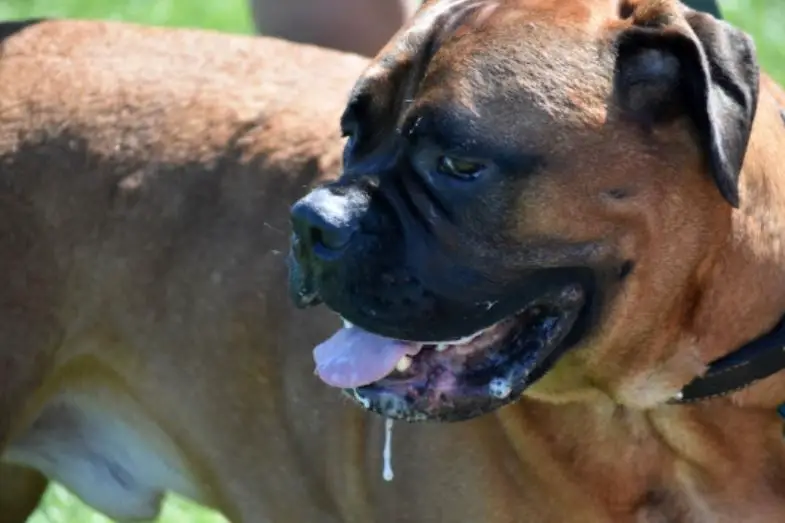Are Bull Mastiffs Dangerous and Aggressive – What’s Their Temperament Like

A Bull Mastiff is deceptive in his appearance. Your dog, when fully grown, will have a massive head and paws the size of saucers. Your pup will develop a built-in guarding instinct, but he’ll only use it when he feels it’s necessary.
What is their temperament like?
Your dog is also known as the “gentle giant.” He is loyal, good-natured, and loving. A Bull Mastiff is an excellent pet for the family. But if your dog feels you or his family is in danger, he can quickly become aggressive.
What are their breed instincts like?
Even though Bull Mastiffs have been bred to be less aggressive, your dog will still have a guarding instinct. This means that’s it’s essential that your pup is trained and socialized. If your dog isn’t socialized, he can become aggressive. Your dog may also develop a guarding instinct towards other dogs.
How much exercise do they need?

Your Bull Mastiff won’t need a lot of exercise and will be content with a few short walks every day. He’s a low energy dog and can adapt to most home environments, but a house with a yard is what’s best suited for him.
How big do they get, and how fast do they grow?
Bull Mastiffs grow slowly, and the female won’t reach full physical maturity until she’s 18 or 20 months old. A male won’t his full size and weight until 3-4 years old.
When a male Bull Mastiff is an adult, his weight will be in the range of 110-130 pounds. He will be about 26 inches at withers. A female will weight between 100-120 pounds when an adult and will be 25 inches at withers. A Bull Mastiff will live from 8-10 years.
Are They Aggressive or When Will They Become Aggressive?

If your Bull Mastiff postures, snaps or growls, or shows teeth, then he is aggressive. A dog that is aggressive can be dangerous to people and other animals. Sometimes dog aggression can be a single event, or it can start your dog’s long-term behavior. Below are some causes of why your Bull Mastiff might be aggressive:
- Agonistic aggression: This kind occurs when there is a conflict between two dogs. One dog or both may exhibit aggression with a reason for it.
- Barrier frustration-aggression: When a dog is tied up, this type of aggression may happen. The dog may feel that he can’t escape or hopeless. So, he becomes aggressive and ready to attack anyone who comes near him.
- Competitive aggression: This type of attack is a social status issue. If two dogs live together under the same roof, one wants to be top dog, so they fight.
- Displaced aggression: If a dog has been abandoned on the streets or has been thrown out of his home, he may show aggression to anyone who tries to talk to him or rescue him.
- Dominance aggression: This type of aggression is when the dog thinks he runs the household and everyone and everything in it. So, he shows aggression to keep everything under control. This aggression will show up, especially when the dog thinks that there’s some conflict challenging his authority.
- Drug-induced aggression: Sometimes, a medication your dog is taking will have a side effect of aggression.
- Fear-induced aggression: Dogs who have been abused show this type of aggression frequently. The dog will snap, bite, or growl because he’s scared and is protecting his life from a threatening situation.
- Food guarding: Dogs who have been abused and on the street searching for food may not understand that people give food, not take it from them. The dog shows aggression because he thinks his food is going to be taken away from him. The dog may also be aggressive towards other dogs or pets in the household.
- Wrong socialization: If the dog has been isolated as a puppy and not appropriately socialized, he can become aggressive.
- Intra-sex aggression: This is when dogs of the same sex show aggressive behavior towards each other.
- Maternal protective aggression: When a mother dog is protecting her puppies, she may become aggressive to anyone who comes between her and her offspring
Bull Mastiffs usually are not an aggressive breed if socialized when he’s young.
Will early socialization make them less prone to aggression and dangerous behavior?
Yes, early socialization will help a Bull Mastiff determine who are good people and who are not. Plus, if he’s introduced to other dogs early, he may become social with them.
Are they dangerous to humans and children (or can they be)?
Generally, Bull Mastiffs get along well with children. If one pulls his ears or tail, he won’t snap at them. A Bull Mastiff was bred to protect, and if brought up properly with children, he will always protect them from danger.
But, if a child is running, wrestling, screaming, or punching or pushing his sibling, your dog may become confused about exactly what’s going on. If your dog thinks the actions are serious, then your dog could interfere, and someone could get hurt.
Children need to be taught that if your dog is sleeping, don’t disturb him. If he’s having a bad day and is resting or not feeling well, a pulled tail may end in a bite.
Your dog should have his own space for when he wants to get away from everything and rest. Remember, this is a big dog, and even if he turns his head sideways, he could knock a child over.
How will your Bull Mastiff react if someone tries to burglar your home?

Bull Mastiffs know their job and have a determined attitude. Your Bull Mastiff may have a laid-back approach with you and your family, but his attitude will change if a stranger shows up. He’s quite suspicious of strangers.
If someone tries to burglar your home, they won’t even hear your dog coming. Your dog would not also bark but knock the person over and hold him down until help showed up.
How will your dog react if someone is aggressive to their owner & loved ones?
Your Bull Mastiff will give his life for you and defend you, the family, and his home.
Do they bark a lot?
No, he is a silent watchdog, only barking when necessary.
Do they bite?
With his size, your dog will detain any unwelcome visitors by pinning them to the floor. He’ll only bite if necessary.
Are they stubborn?
Yes, Bull Mastiffs can be stubborn, especially in their younger years, before maturity. When your dog hits one of these stubborn phases, go back to the basic obedience lessons, and request complete obedience from him.
How are they with other dogs in the home or in public?
You can train your Bull Mastiff to act appropriately around other dogs and pets if trained.
What about cats and other small animals?
If your cat or other small pet runs, then the predator instinct may come out in your dog. Your dog may have a problem with dogs of the same sex. His guarding instinct may show up, and it can cause aggression.
Are they banned anywhere?
There are several states and countries where Bull Mastiffs are forbidden. People see the breed and think the worse. These dogs are judged without any real evidence.
Bull Mastiffs are one of the breeds which have been targeted for breed-specific legislation. But some studies argue that just because a dog is a particular breed is not a useful barometer for how dangerous the dog could be.
Are They Easy to Train?

A Bull Mastiff was bred to work alone, patrolling the grounds and properties of his owners. This gives the breed an independent attitude that comes across sometimes as willful disobedience or of a dog of lesser intelligence.
But a Bull Mastiff is used to thinking for himself and figuring things out. He sees little need for repeating an action command such as sit, repeatedly.
The best method for training your dog is positive reinforcement, patience, a gentle but firm guidance, and gentleness. If you use a harsh training method, it can create an aggressive dog.
Tips For Training Bull Mastiffs
Before you even begin training, you will need to purchase your pup a collar. Getting a collar on your puppy as soon as 8 weeks is essential. Let it on for a few hours a day, so he gets used to wearing it.
When you are training your Bull Mastiff, he will become bored quickly. You’ll need to keep the lessons short and not near any distractions. When he does something correctly, let your pup know with praise and a treat. Use an excitable voice when he has done a command correctly. If your dog is being rowdy, displaying unwanted behavior, or being disobedient, give him a firm and loud, “NO!”
With a Bull Mastiff, because they are so food-driven, using edible, tasty treats can go a long way with training. Teaching him the “watch” command is an excellent command to teach your dog. It’s because when you say “watch” you are asking for your pup’s undivided attention.

To teach this command, have a treat in your hand and say “watch” as soon as he looks your way. Give him the treat and praise as soon as he does it. When he catches on, then start telling him to “watch” without food. You don’t want your dog to depend solely on treats for good behavior. Extend the “watch” period over time.
Since Bull Mastiffs do become easily bored, don’t be repetitive with your commands. Use only 15 minutes at a time for training. It will give you enough time to go over the basic commands like stay, sit, drop, and come. When first starting out, just work on one command for a few minutes a day until your dog gets it.
Once your pup has a command down, review it with him and start on another one.
Another thing is to think beyond your puppy’s early years. What’s acceptable now may not be when he weighs 130 pounds. He might be cute all snuggled up in your lap, but it’s a different equation at full adult size. Once you start a habit with your dog, it’s difficult to break.
Even housetraining shouldn’t be an issue if you make it a positive experience. You need to provide him with a regular schedule with lots of opportunities to go outside. You should consider crate training as a tool for housetraining and keeping your chewing puppy safe.
You need to remember that your pup is an independent thinker. If you don’t guide him and let him have his own way, your dog will be running the household. You need to expose this breed to different places, sights, sounds, and people.
Remember, your dog may reach 130 pounds of sheer muscle. You want a dog that is responsive to you, listens to your commands, well-trained and socialized.
Conclusion & Key Takeaways
Bull Mastiffs are a wonderful breed of dogs who are faithful and loyal. When trained correctly, they make an excellent watchdog and member of the family. If socialized, your dog will be friendly towards friends, family members, and strangers.
One more thing to consider is buying your pup a bib. He will slobber and drool, and a bib will catch most of it. All in all, if you think a Bull Mastiff is for you, then go for it.
For more information, check the link below:
References:
https://pets.thenest.com/bullmastiffs-dangerous-8572.html
https://www.hillspet.com/dog-care/dog-breeds/bullmastiff
https://dogtime.com/dog-breeds/bullmastiff#/slide/1
https://dogtime.com/dog-breeds/bullmastiff
https://www.dog-breed-bullmastiff.com/bullmastiff-and-aggression-types-of-aggression-ezp-36.html


